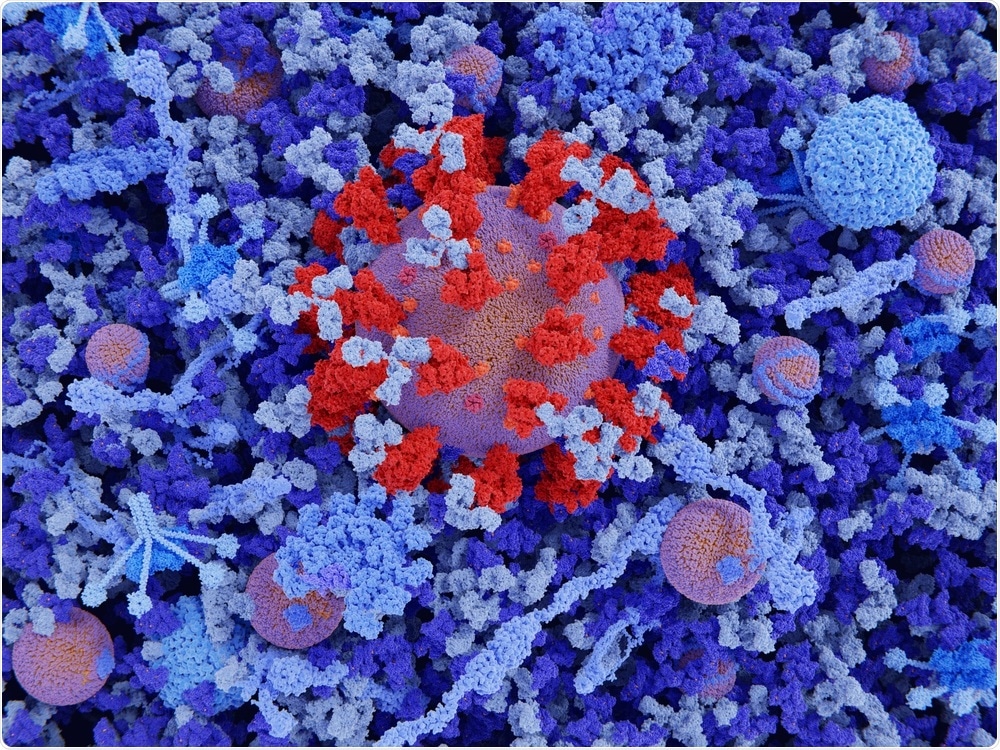
Emerging reports on breakthrough severe acute respiratory syndrome coronavirus 2 (SARS-CoV-2) infections, along with the data on novel SARS-CoV-2 variants of concern (VOCs), threaten the notion of immune protection following primary infection or vaccination.
Knowledge on the duration of protective immunity resulting from both natural infection and vaccination is critical, as this would have key implications for relaxing the stringency of non-pharmaceutical interventions (NPIs).
 Study: Does infection with or vaccination against SARS-CoV-2 lead to lasting immunity? Image Credit: Juan Gaertner / Shutterstock.com
Study: Does infection with or vaccination against SARS-CoV-2 lead to lasting immunity? Image Credit: Juan Gaertner / Shutterstock.com
In a recent Lancet Respiratory Medicine study, researchers have presented a comprehensive assessment on SARS-CoV-2 induced immunity after evaluating a large body of emerging immunological data on SARS-CoV-2 infection, along with literature on other common human respiratory viruses.
Based on available data, the team suggests that the duration and breadth of the immunological response to SARS-CoV-2 infection vary markedly by age and disease severity, with detectable neutralizing responses present for up to one year after infection.
Lessons learned from other respiratory viral infections
SARS-CoV-2 has evolved various mechanisms to evade the innate immune response to infection, with host recognition mechanisms and viral immune evasion pathways showing some similarities to those of previous pandemic coronaviruses.
Patients who previously recovered from SARS-CoV had detectable circulating immunoglobulin G (IgG) responses for 2-3 years after infection, and neutralizing antibodies were identified for even up to 12 years after infection. Similarly, in patients who have recovered from MERS-CoV, neutralizing antibodies were detected for up to 18 months.
Studies on other respiratory viruses, including the seasonal coronaviruses, respiratory syncytial virus, and influenza virus, indicating that the production of neutralizing antibodies provides only transient protection for up to a 12-month window against reinfection.
Strength of antibody-mediated/humoral immunity apparently varies with COVID-19 severity
The presence of neutralizing antibodies is typically seen as one of the best correlates of effective immunity for a variety of pathogens.
Patients with severe COVID-19 have antibodies raised against a range of viral antigens, with the majority of neutralizing antibodies targeting epitopes on the spike protein and its receptor-binding domain (RBD). Higher initial neutralizing antibodies titers are detected in patients with more severe disease as compared to those with milder disease; however, emerging evidence suggests that these differences are lost within a few months owing to rapidly waning titers.
Regarding long-term antibody dynamics, data are consistent with detectable neutralizing antibody responses lasting 8-12 months in patients with severe disease. Delayed neutralizing antibody responses have also been associated with fatal outcomes and early neutralization has been correlated with faster viral clearance.
Studies on individuals with mild disease indicate reversion to seronegativity by 4-6 months in a small proportion of patients. There is also evidence for a large proportion of individuals mounting weak primary humoral responses among those with mild disease. Although there is substantial variation within and between studies, the data might be consistent with a prolonged humoral response over 5-6 months.
In asymptomatic patients, the decline in circulating antibody levels appears to be more pronounced than that in symptomatic patients. A comparative study on asymptomatic and symptomatic patients identified, in the convalescent phase, that 40.0% of asymptomatic patients reverted to IgG seronegativity as compared to only 12.9% of symptomatic patients.
Moreover, a trend for declining IgG titers and neutralization rates across almost all patients highlights a short-lived nature of the circulating humoral response. Similar observations were drawn from an analysis of asymptomatic individuals in Wuhan, China, of whom 36.5% did not produce neutralizing antibodies. Among those who did, circulating levels began to fall after 25 days.
Together, these data suggest that the initial magnitude of response and speed of decline vary with disease severity.
Humoral immunity and prevention of reinfection
Two large prospective cohort studies on healthcare workers estimated that individuals who were seropositive for anti-spike IgG at baseline had an 88% and 83% reduced risk of infection, respectively, relative to those who were seronegative at baseline. In both studies, the median time to reinfection was 5-6 months.
Another retrospective cohort study involving 3.2 million people in the United States showed that individuals who were seropositive for IgG, IgA, or IgM antibodies at baseline had a ten-times reduced risk of testing positive for SARS-CoV-2 90 days later as compared with those who were seronegative at baseline.
Current evidence suggests that reinfection can occur within 5-12 months of primary infection, and the humoral response is a key element of the host response to protection against SARS-CoV-2 reinfection. Nonetheless, it is unclear whether the time to reinfection suggested by the available data could become shorter with escape from neutralization by VOCs.
Humoral memory to SARS-CoV-2
While SARS-CoV-2 neutralizing antibodies might decline over 5-12 months, memory B-cells (MBCs) are maintained or even increase in frequency, undergo extensive clonal expansion, and generate potent neutralizing antibodies against the RBD upon rechallenge. Hence, the longevity of MBCs capable of producing neutralizing antibodies might counteract the pitfalls of a relatively short-lived circulating antibody response.
The frequency of MBCs has been found to correlate negatively with symptom duration and increases following recovery from infection, thereby indicating a potential role in ameliorating disease severity. However, emerging evidence suggests that MBCs might evolve towards non-neutralizing profiles over time, particularly in older patients, thus highlighting the benefit of vaccination.
Cell-mediated immunity in natural SARS-CoV-2 infection
Whereas antibody responses to a range of respiratory viruses are transient, the T-cell response, which is targeted against internal and conserved proteins, tends to be longer lived. The severity of COVID-19 has been shown to be negatively associated with T-cell counts (with lymphopenia being a classic sign of severe COVID-19) and positively associated with the abundance of proinflammatory cytokines. These observations point to the importance of an appropriately proportioned cell-mediated response in effecting SARS-CoV-2 clearance.
Cell-mediated responses to disease severity
A large proportion of T-helper (CD4+) cells has been observed to be produced against highly expressed SARS-CoV-2 proteins, particularly the spike, membrane, and nucleocapsid proteins. Further, spike-specific CD4+ T-cell responses correlate well with the magnitude of anti-RBD IgG titers, thus indicating a coordinated cellular and humoral response to the virus. Indeed, a lack of coordination is associated with more severe disease.
A large breadth of epitope binding targets has been shown for CD4+ and T-cytotoxic (CD8+) cells. Asymptomatic individuals can develop a robust memory T-cell (MTC) response, even in the absence of detectable antibodies.
Similar to the humoral response, the magnitude of the cell-mediated response appears to be associated with disease severity. This has been demonstrated in a study on COVID-19 patients, where all T-cell counts, particularly CD8+ counts, were lower in non-survivors compared with survivors.
SARS-CoV-2-specific T-cell counts decrease with increasing age, perhaps accounting for the well-documented increased likelihood of poorer prognoses among older individuals. Taken together, these findings suggest that an effective T-cell response protects against severe outcomes in SARS-CoV-2 infection and that cell-mediated immunity to SARS-CoV-2 infection is robust and durable to small mutational changes.
Cell-mediated memory to SARS-CoV-2
MTC responses outlast those of MBCs in various studies of previous pandemic coronaviruses. Research on cell-mediated aspects of SARS-CoV-2 infection has similarly demonstrated the production of long-lived cytotoxic MTCs (half-life 125–225 days), thus raising the possibility that cell-mediated immune memory to SARS-CoV-2 could provide effective protection against reinfection.
Adaptive immune responses to SARS-CoV-2 vaccination
Early clinical data on the SARS-CoV-2 adenovirus vector vaccine ChAdOx1 nCoV-19 by Oxford-AstraZeneca showed the development of a spike-specific T-cell response as early as 7 days after vaccination, which was retained until day 56.
Early data on the Pfizer-BioNTech messenger ribonucleic acid (mRNA) vaccine also demonstrated 95% effectiveness against disease, measured at 7 days after vaccination. Strong and correlated CD4+ and CD8+ T-cell responses were raised against a variety of spike epitopes 7 days after the booster dose. Furthermore, the Moderna mRNA vaccine mRNA-1273 elicited a robust CD4+ type 1 helper T-cell response in a phase 1 trial, with concurrent production of interleukin 2 (IL-2), tumor necrosis factor (TNF), and interferon γ (IFN-γ).
In addition to a strong cell-mediated response, numerous trials have shown the development of robust humoral responses in participants after vaccination. Phase 1/2 data of the BNT162b2 vaccine showed higher neutralizing titers following the primary dose as compared to those observed among naturally infected convalescing patients. Humoral responses after mRNA-1273 vaccination were also substantial, with serum neutralization detectable in all participants following the second dose.
Vaccines show compromised efficacy against some VOC
Evidence on the T-cell response to VOCs suggests that SARS-CoV-2 vaccination elicits a strong cell-mediated response against VOCs, with the exception to the SARS-COV-2 Beta variant.
Emerging data on the humoral response to VOCs has shown reduced viral neutralization in response to both natural infection and vaccination. A trial of the ChAdOx1 nCoV-19 vaccine showed a substantial decrease in efficacy against mild-to-moderate COVID-19 caused by the Beta variant. Individuals vaccinated with mRNA vaccines have also demonstrated reduced viral neutralization against the Gamma and Zeta variants.
Overall, data on the immune response to VOCs demonstrate the need for broadly protective SARS-CoV-2 vaccines.
Conclusions
Overall, the compiled study suggests that the duration of the humoral response to SARS-CoV-2 infection varies with age and disease severity. Neutralizing responses may be present for up to ONE year, with MBCs sustained for many months after recovery from infection. A potent MTC persists for 5-8 months after infection and might be mounted in the presence of low antibody titers, thus reducing disease severity upon rechallenge.
Vaccination elicits a spike-specific immune response of greater specificity and magnitude than that of natural infection; however, vaccine effectiveness is impaired against VOCs.
“Given the considerable viral epitopic mutation, it is likely that SARS-CoV-2 vaccines will need to be updated on a seasonal or yearly basis to maintain population-level protective immunity, as is the case with other endemic respiratory viruses; other interventions might also be required to prevent the occurrence of further significant outbreaks and reduce the incidence of disease.”
- Milne, G., Hames, T., Scotton, C., et al (2021) Does infection with or vaccination against SARS-CoV-2 lead to lasting immunity? The Lancet Respiratory Medicine. doi:10.1016/S2213-2600(21)00407-0, https://www.thelancet.com/journals/lanres/article/PIIS2213-2600(21)00407-0/fulltext
Posted in: Medical Science News | Medical Research News | Disease/Infection News | Pharmaceutical News
Tags: ACE2, Adenovirus, Antibodies, Antibody, Antigen, Apoptosis, CD4, Cell, Coronavirus, Coronavirus Disease COVID-19, Cytokines, Efficacy, Frequency, Gene, Genes, Genome, Healthcare, Immune Response, immunity, Immunization, Immunoglobulin, Influenza, Interferon, Interferons, Interleukin, Lymph Nodes, Lymphocyte, Lymphopenia, Lysosomes, Medicine, Membrane, MERS-CoV, Mutation, Necrosis, Pandemic, Phosphorylation, Protein, Receptor, Research, Respiratory, Respiratory Syncytial Virus, Ribonucleic Acid, RNA, SARS, SARS-CoV-2, Severe Acute Respiratory, Severe Acute Respiratory Syndrome, Spike Protein, Syndrome, T-Cell, Transcription, Transcription Factors, Tumor, Tumor Necrosis Factor, Vaccine, Virus

Written by
Namita Mitra
After earning a bachelor’s degree in Veterinary Sciences and Animal Health (BVSc) in 2013, Namita went on to pursue a Master of Veterinary Microbiology from GADVASU, India. Her Master’s research on the molecular and histopathological diagnosis of avian oncogenic viruses in poultry brought her two national awards. In 2013, she was conferred a doctoral degree in Animal Biotechnology that concluded with her research findings on expression profiling of apoptosis-associated genes in canine mammary tumors. Right after her graduation, Namita worked as Assistant Professor of Animal Biotechnology and taught the courses of Animal Cell Culture, Animal Genetic Engineering, and Molecular Immunology.
Source: Read Full Article